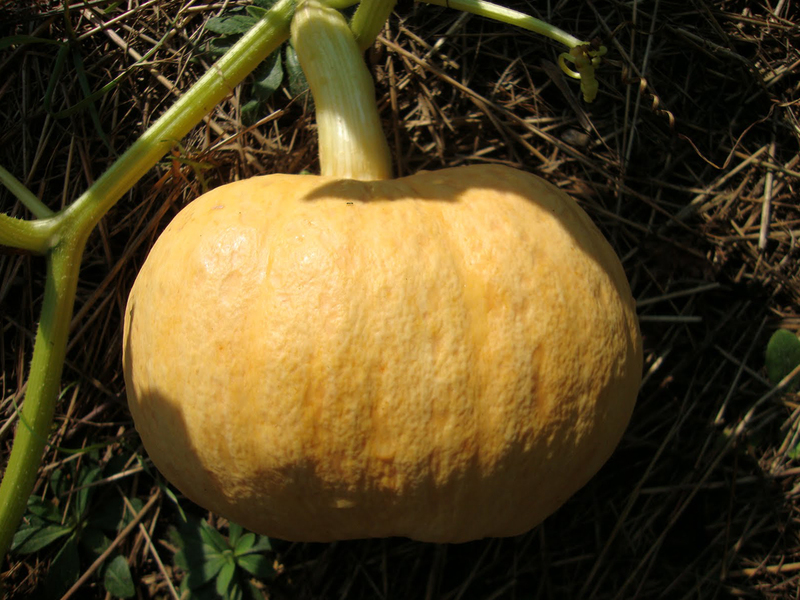The TV series “The Flintstones” decided to add a baby to the show in 1963. The first choice was to add a boy, but the baby was switched to a girl so they could sell dolls, and animal-skin-clothed Pebbles was born. In the Bible, saints are often given attributes so they can be recognized at once, like halos on holy men or wings on angels. John the Baptist would become famous later in life as a man wandering the deserts dressed in animal skins, but to identify John the Baptist, even as a child in paintings he is portrayed wearing animal skins.
John The Baptist has his animal skins for an attribute, and some garden vegetables have as their attribute, their color. Bright orange flesh in vegetables such as sweet potatoes, often means high nutrition. Winter squash has orange flesh true to its attribute as high in beta-carotene, and ranks among the most nutritious foods you can eat. While all squash originated in the Americas, some have made a roundabout journey home.
From Australia the ribbed peach-colored heirloom Australian Butter Squash (Cucurbita maxima) comes with a full attribute of thick, orange, silky flesh filled with vitamins. The squash is equally home as a vegetable topped with butter or sweetened and spiced into breads and pies. Each fruit grows to about 15 pounds. The rare Australian Butter Squash stores perfectly well into spring.
From the Old South of the United States comes hysterically named Tweet-ee-oo-Bakers Squash (Cucurbita pepo). The name alone is worth growing it. The vigorous vines yield five- to 10-inch thick yellow fruits with green stripes. These squash look like a squatter form of Delicata squash. The flesh is moist and mild-flavored.
Since this is a member of the same family as zucchini (also Cucurbita pepo) it is no surprise that you can use young Tweet-ee-oo-Bakers Squash just like you use crookneck squash or zucchini. Once Tweet-ee-oo-Bakers Squash is fully mature, use it as you would any winter squash for soup, as a mashed vegetable served with butter, baked into pastries, breads and pies, or made into jam, and yes, ice cream.
Northern Italy gives us the blue-gray Berrettina Piacentina squash (Cucurbita maxima), an orange-fleshed squash weighing 10-20 pounds. The vines are huge, often running to 30 feet or more.
Because the nutty flavored flesh is rather dry, it is easy to incorporate into baked goods,, and holds up well as filling for raviolis. This is not to say it is only good for baking. Berrettina Piacentina squash forms the base of a delicious, vitamin-rich sauce for pasta.
The Long Island Cheese Squash gets its name because it looks just like a big buff wheel of cheese. This six- to eight- pound heirloom dates back at least to 1824. The firm orange flesh makes fantastic pies, and the uncut squash will store seemingly forever.
Seeds for unusual squash are often found at local nurseries and garden centers or by mail from seed companies such as Baker Creek Heirloom Seed Co. (www.rareseeds.com, 2278 Baker Creek Road, Mansfield, MO 65704; phone: 417-924-8917); Adaptive Seeds (25079 Brush Creek Road, Sweet Home, OR 97386; at www.adaptiveseeds.com); Pinetree Garden Seeds (P.O. Box 300, New Gloucester, ME 04260; phone 207-926-3400). Another seed source, Sand Hill Preservation, no longer publishes a print catalog, but is available online at www.sandhillpreservation.com.
To grow winter squash after all danger of frost is past, plant the seeds directly in the garden in fertile soil that you have enriched with well-rotted manure or compost. Plant seeds about one to two inches deep in hills of six or eight seeds apiece. Thin the plants out to two or three plants per hill. Space the hills two to three feet apart in rows four feet apart. Keep squash plants well watered but not soggy. Fertilize every few weeks during the growing season with organic fertilizer such as fish emulsion or compost tea.
Many gardeners have better success growing vine crops such as squash on black plastic and by using row covers for insect control and to hold down weeds.
You can start winter squash plants two or three weeks indoors and transplant them out after the ground has warmed up. Don’t try to rush the season by setting out transplants that are too big. Transplant indoor- started squash before the plants have grown no more than two or three true leaves.
After about 100 days or so you will have your crop of winter squash. Harvest all winter squash before severe frost. Squash is ripe when you can’t break the skin with your fingernail. Cut the squash from the vines rather than twisting the stems so you get a clean cut. Leave at least two inches of the stem on the squash so it won’t rot from the top down.
Winter squash will store longer if you let squash sit in the sun to cure for seven to 10 days to harden the rind.
Grow your own winter squash from around the world and be aware of the attribute of orange healthy flesh. Eat the high beta-carotene Tweet-ee-oo-Bakers squash perhaps while swaddled in animal skins and you can honor John the Baptist, or Pebbles.

















































